Every horse farm, large or small, needs options to control biting horse flies and deer flies.
From June through September, give or take, we battle deer flies and horse flies on our little horse farm. They make it difficult to do much of anything with the horses. Fly sprays aren’t very effective, they will bite right through fly sheets, and the bites HURT. My horses are both pretty reactive to pressure, but they will let me smack a horse fly hard enough to stun and squash it. Even if I am smacking a butt or a leg. One horse used to run to me to get me to kill one that landed on him. I was his hero!
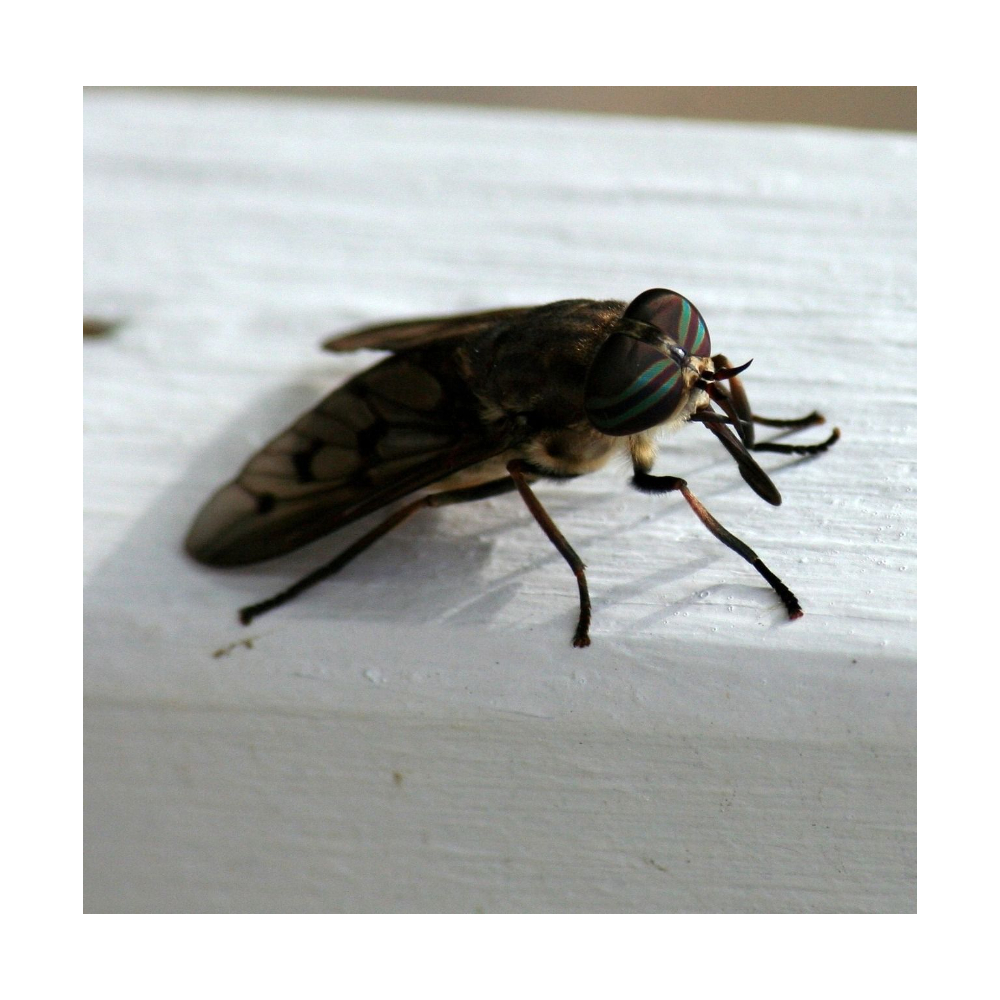
Fly Control Options
With flies and other insects, your choices, generally, are:
- Traps that lure, then capture (sticky, or other physical trapping)
- Sprays and liquids that repel,
- Poisons that kill,
- Predators that break the life cycle (fly-predators),
- Feed through chemicals that break the fly life cycle,
- Traps that masquerade as the fly’s favorite prey.
I will be expanding on some more of these in a separate post. But now is horsefly season, so I will focus on how we deal with them, and some of the things we have tried.
Horse Flies and Deer Flies
Most of the methods above do not work for horseflies and deer flies. These flies are also known as Tabinids, B57s, Bomber flies and also by some names I won’t include here…. Unfortunately, many fly control methods are ineffective with these flies. They are not very attracted to odors of food or rotting material, or even dead stuff. They are attracted to heat, carbon dioxide, and the visual appearance of their prey. They are seeking large warm-blooded bodies to feed on. Cattle, deer, horses, and humans make ideal targets.
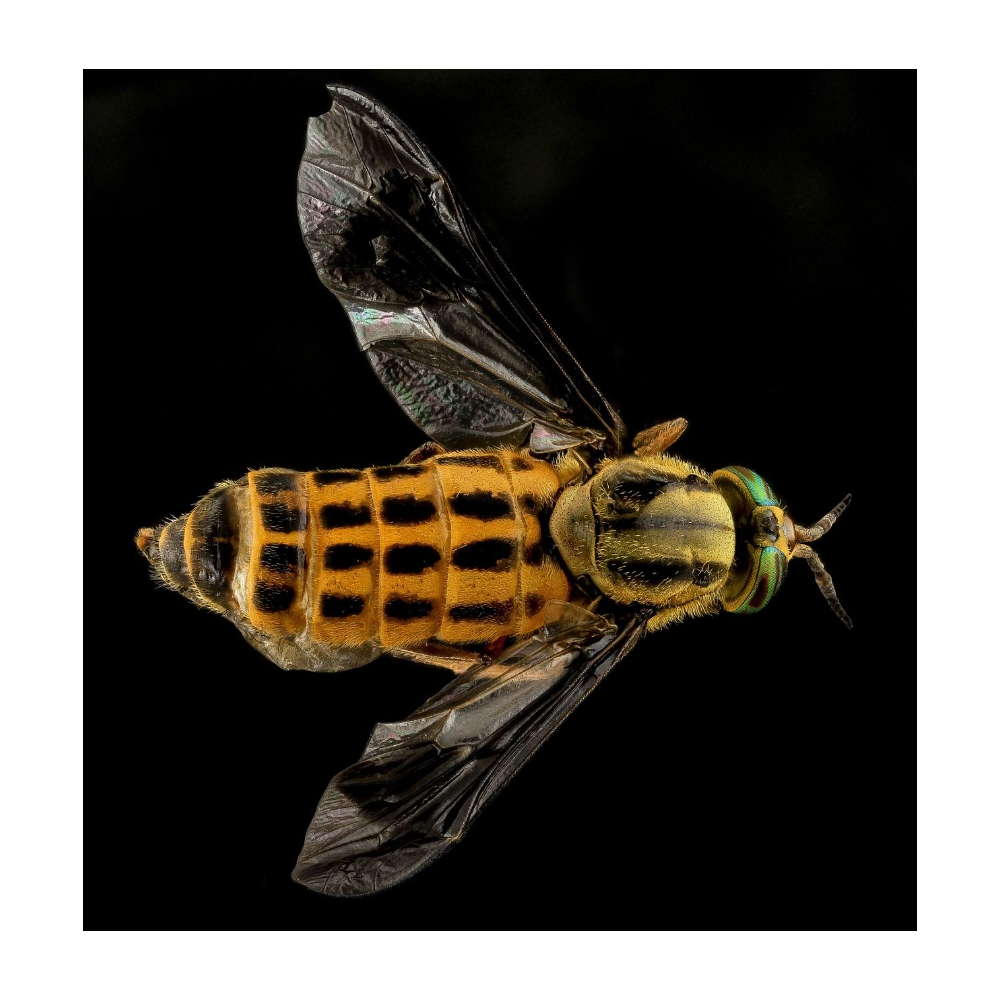
Disrupting their life cycle is difficult, because they are water breeders. Mosquitoes are a little easier to control in our area, because they require stagnant water. Keep everything emptied of water, clean water troughs weekly, and encourage bats and hummingbirds and you will have less mosquitoes. Unless you live by a pond or swamp or wetland with stagnant water!
In our case, we have streams and rivers. Moving water breeds less mosquitoes, but more horseflies. These aren’t the common flies that buzz around harassing your horses. These are the inch-long “bomber” flies that are more bite than bark.
A little research will tell you that it is the female horsefly that bites – she needs blood to reproduce. The horses and I are her targets – large warm bodies are what she is seeking.
Fly Challenges
Horse flies and deer flies are not generally repelled by fly sprays. Fly predators do not attack their larvae. Manure doesn’t attract them, so feed through solutions aren’t effective. While they are not immune to poisons, I suspect it would take large doses, and quick applications to work.
So the one thing we have seen that seriously puts a dent in the population of these flies, is a trap that masquerades as prey. We have tried several available traps, and have made others with varying degrees of success. My favorite is this one:
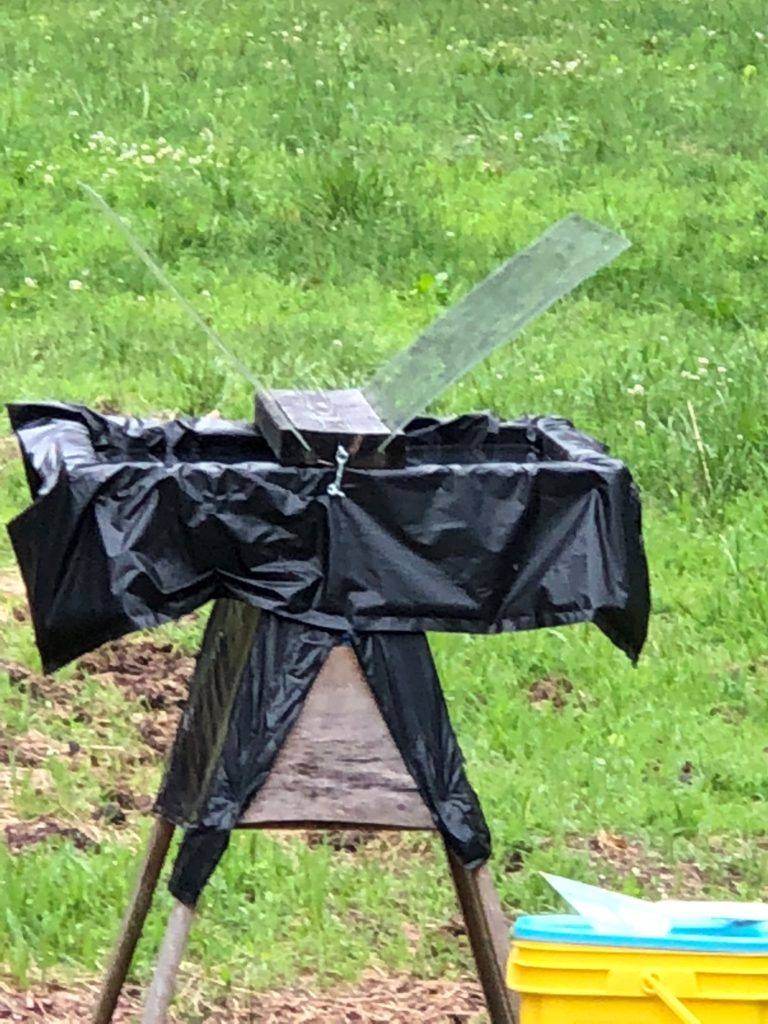
Angus
We have made several of these traps. We call them ANGUS. They are based on a DIY design by Dan Owsley (look him up online – Dan Owsley Fly Trap). These are inexpensive to build, easy to move around and VERY effective.
We simply used a wooden saw horse from a building supply store as the base. Then built and attached a shallow wooden box. Cover the box with heavy black plastic. The black plastic mimics the fly’s prey, and gets warm in the sun. Extra plastic that moves a bit in the wind is good – the flies are looking for warm-blooded moving prey. We also painted the legs black, but it wears off over time. The one pictured above is about 3 years old.
The board across the center has grooves cut in with a table saw in to hold the Plexiglas sheets at about a 45 degree angle. This center board should be painted black so it doesn’t reflect in the Plexiglas.
Then simply fill the plastic box with water, add a squirt of dish soap, keep the Plexiglas fairly clean and you are in business!
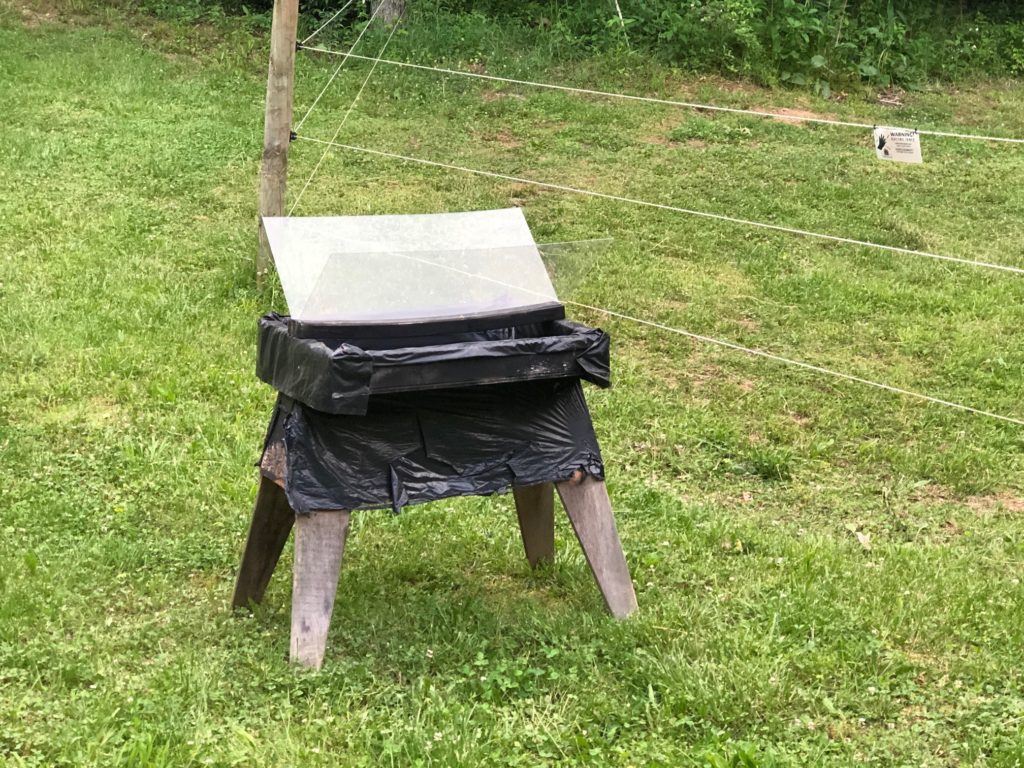
How it works:
The female biting fly sees what she believes is a large, warm bodied mammal that will provide the blood meal she seeks. When she reaches the impostor, she realizes her error. Her response, and normal flight pattern is to fly straight up. She is flying fast. When she hits the Plexiglas sheet. she is knocked into the water. The soap keeps her from being able to fly out of the water, and she immediately drowns.
Most sources recommend keeping the drowned flies scooped out of the water. I keep an old cat letter container and a wire strainer next to the trap for this purpose. I leave a little clay litter in the bottom of the bin and it dehydrates the flies and keeps them from becoming smelly.
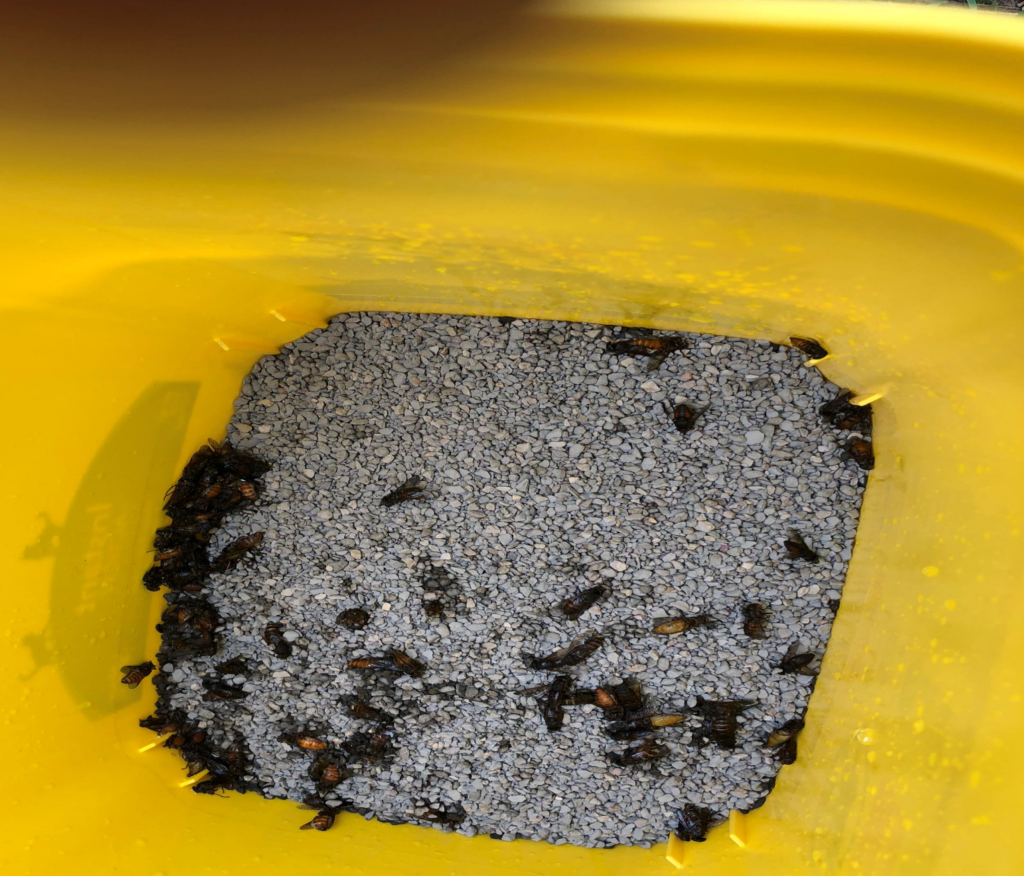
Keep the black “tub” topped off with water and soap – it will evaporate over time. When the water gets too murky, I dump it our and start over with clean water.
Placement is important, and probably the biggest challenge. I have found that it works best placed in an open field, in sight of the woods or wetlands, but not too close. The best thing is to move it around a bit and see what works best for you.
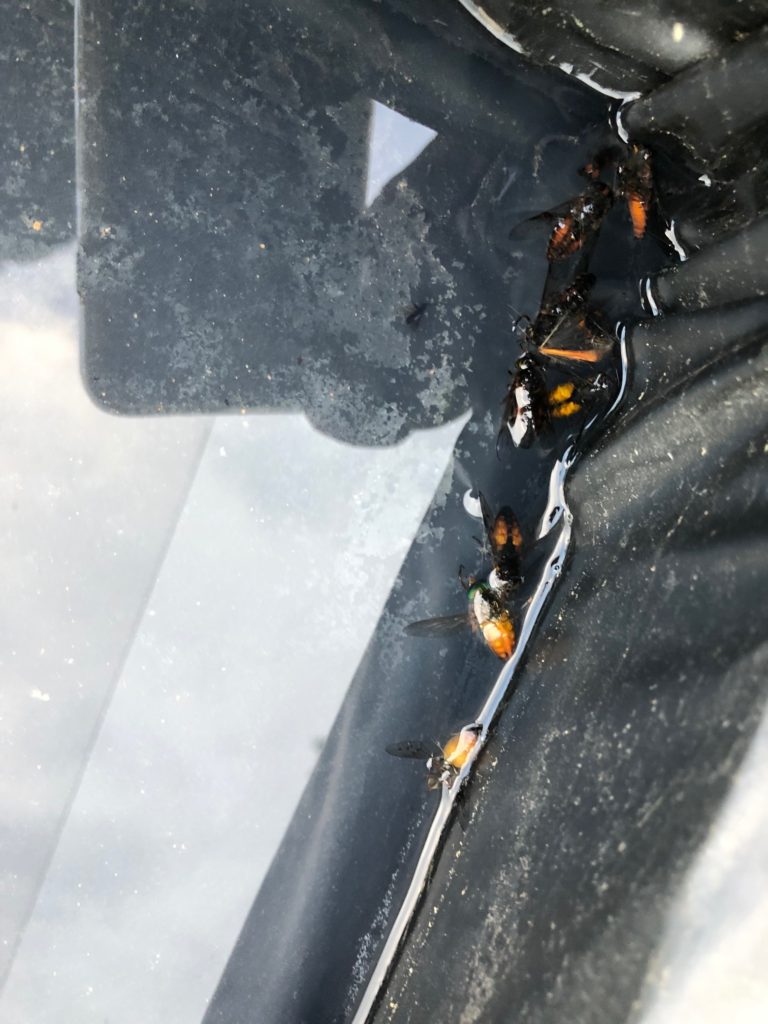
I put these traps right in the horse pasture, but my current horses leave them alone. I have had horses in the past that would tear them up and play with the pieces, so be warned.
Not into DIY?
First a brief disclaimer: I have not tried most of these products on the market, so I am not endorsing them. Only discussing the availability and giving you some ideas to research.
If you are not into building a trap yourself, there are traps on the market based on this same principle. Most are pretty expensive. I bought one before I started making the Angus trap. It consists of a nylon box on legs with a hanging buoy below the “box” and fine mesh on top. The same principle, but not very successful. I have been playing with modifying it and will see if my changes help.
The EPPS Biting Fly Trap works on the same principle as Angus – A structure that mimics the appearance of the fly’s favorite prey – using dark plastic sheeting on T-posts, with clear deflectors and trays of soapy water. I suspect it works well, but the price tag has kept me from testing it.
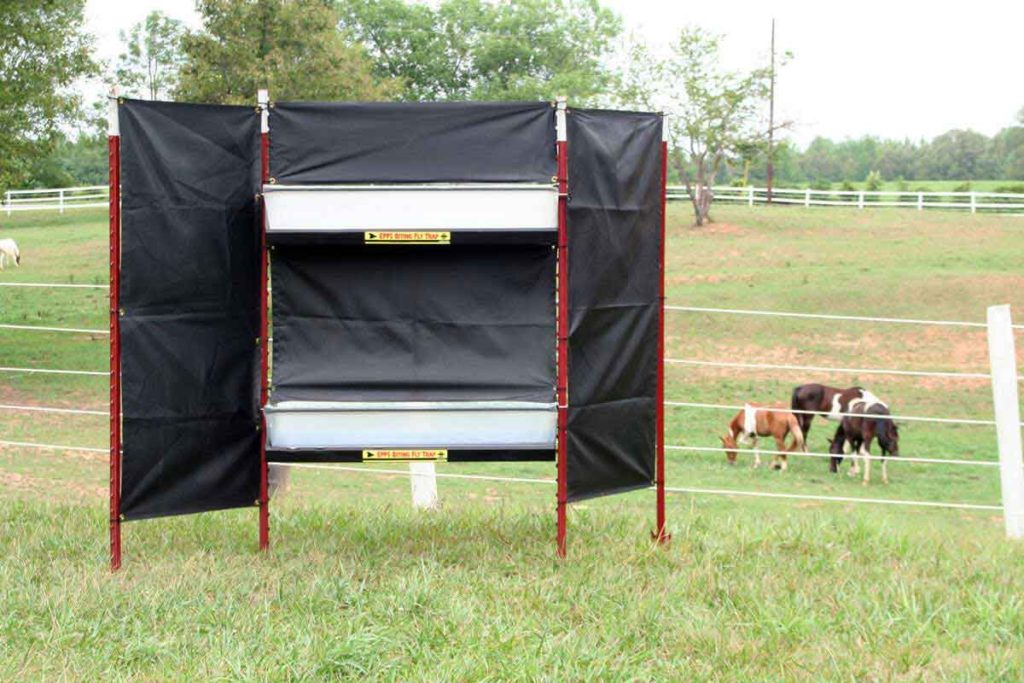
Others on the market use hanging balls with a net and capture system suspended above the ball. Bite-Lite’s H-Trap is one example. Another is the Horse Pal Trap.
Another one on the market is the Bug Ball, a trap also designed for horse flies and deer flies. It is a large dark ball used as a visual lure, but you need to buy TangleTrap or another sticky coating and paint the coating on the ball to capture the fly when it lands. Personally, I would hesitate to use this inside my pastures, because it would be my luck that a curious horse would get his mane or tail stuck to it. I also don’t think I would want to clean the flies off the ball, so I would be buying new sticky balls. I have also seen some comments about these traps capturing beneficial species and even insect eating birds. I would hate to trap one of our many precious hummingbirds on a sticky trap.
Is it worth it?
As part of my multiple arsenal of weapons against flies, traps that reduce the populations of those horrid biting flies, are very valuable. I have had great success with our homemade Angus traps, based on the Dan Owsley trap. But I am continuously looking for additional weapons for the war on flies.
And it may be my imagination, but I think after three years, of battles, I am seeing less biting horse flies. Perhaps it’s a natural cycle, and next year will be worse, but I am an optimist. Right now, I choose to believe that fighting the good fight at least keeps the flies at a level that my horses, and I, can live with!
Are you also fighting the fight?
I believe the range of these flies is extensive. Are you in an area with these biting flies. Please comment and share your experiences. If you have tried or found tools that reduce their numbers and/or the impact on you and your horses, I would love to hear from you.
I am also working on a post regarding the methods we have tried to reduce the numbers of other flies. You can find it here: https://randomcanyoncrafts.com/5-working-tips-for-the-best-fly-control-for-horses/
Sign up for my newsletter to be notified of new posts.
These battles include the biological control using tiny fly-killing wasps, as well as various traps. Here is one of my favorites!

Thank you for your guidance. I found this article very interesting and helpful in my approach.
You are welcome, Stephanie. I am happy that this post helped. I would love to know what you try and how it works for you. The battle with these biting flies is REAL! – Haila